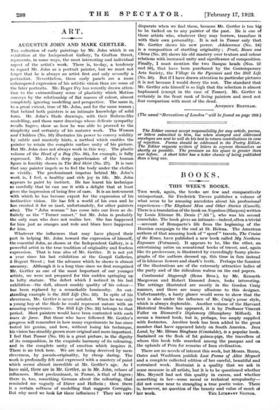ART.
AUGUSTUS JOHN AND MARK GERTLER. THE collection of early paintings by Mr. John which is on exhibition at the Independent Gallery, 7a Grafton Street, represents, in some ways, the most interesting and individual aspect of the artist's work. There is, to-day, a tendency to regard Mr. John as a portrait painter, but we must not forget that he is always an artist first and only secondly a portraitist. Nevertheless, these early panels are a more unhampered expression of his artistic vision than are some of the later portraits. Mr. Roger Fry has recently drawn atten- tion to the extraordinary sense of plasticity which Matisse conveys by the relationship of flat masses of colour, almost completely ignoring modelling and perspective. The same is, to a great extent, true of Mr. John, and for the same reason ; that behind both painters is an intimate knowledge of solid form. Mr. John's Slade drawings, with their Rubens-like modelling, and those rarer drawings whose delicate sympathy recalls Ing,res, show us how he was able to proceed to the simplicity and certainty of his maturer work. The Woman and Children (No. 10) illustrates his power to convey solidity by subtle and masterly hints, a method which enables the painter to retain the complete surface unity of his picture. But Mr. John does not always work in this way. The plastic volume of the Head of a Boy (No. 86), for example, is fully expressed. Mr. John's deep apprehension of the human. figure is forcibly shown in The Red Skirt (No. 27). It is rare that any painter impels us to feel the body under the clothes so vividly. The predominant impetus behind Mr. John's work is, I feel, a healthy and rich joy in life. Mr. John appears to paint by instinct. He has learnt his technique so carefully that he can use it with a delight that at least gives the impression of being free of care. It is an instrument with which he has become expert for the expression of his instinctive vision. He has felt a world of his own and he has created it for us (and, unfortunately, for other painters also). The " John woman " has come into our lives as de- fmitely as the " Turner sunset," but Mr. John is probably the only man who does not realize her. She has happened for him just as oranges and reds and blues have happened for him.
Whatever the influences that may have played their part in helping Mr. John toward the expression of himself, the essential John, as shown at the Independent Gallery, is a powerful artist in the true tradition of originality and fearless expression. That is true also of Mr. Gertler. It is not yet a year since his last exhibition at the Goupil Galleries, 5 Regent Street ; but the advance which he shows is almost uncanny. Although it is a long time since we first recognized Mr. Gertler as one of the most important of our younger artists, we were not prepared for this sudden springing up to lofty stature. The defect which I noticed in his last exhibition—the dull, almost muddy quality of his colour— has been replaced by a remarkable luminosity. An out- standing example is the Still Life (No. 35). In spite of his cleverness, Mr. Gertler is never satisfied. When he was only a young boy at the Slade he could represent nature with an amazing competence.. The Still Life (No. 82) belongs to that period. Most painters would have been contented with such tours de force. But those who have followed Mr. Gertler's Lprogress will remember in how many experiments he has-since tested his genius, and how, without losing his technique, his vision has steadily grown more original and more impoitant. I feel that Tamar (No. 18) is a great picture, in the dignity of its composition, in the exquisite harmony of its colouring, and in the complete unity of emotion which inspires it. There is no trick here. We are not being deceived by-mere cleverness, by pseudo-originality, by cheap daring. The work is profoundly felt and expressed with a mastery of paint which seems iJ.triost incredible at Mr. Gertler's age. As I have said, there are in Mr. Gertler, as in Mr. John, echOes of influences. Most predominant, in Tamar, is that of Ingres ; there is, too, something German about the ecilouring, that reminded me vaguely of Diirer and Holbein ; then ..there Is a certain softness of modelling that suggests Correggio. gut why need we look fat these influences ? They are_ very disparate when we find them, because Mr. Gertler is too big to be tacked on to any painter of the past. He is one of those artists who, whatever they may borrow, transfuse it with their own personality. It is not in Tamar only that Mr. Gertler shows his new power. Adolescence (No. 24) is a composition of startling originality ; Fruit, Roses anti China (No. 20) shows his old mastery over texture and colour relations with increased unity and significance of composition. Finally, I must Mention the two Basque heads (Nos. 29 and 36), that have been purchased by the Contemporary Arts Society, the Village in the Pyrenees and the Still Life (No. 30). But if I have drawn attention to particular pictures it is not because I would decry the rest. The standard that Mr. Gertler sets himself is so high that the selection is almost haphazard (except in the case of Tamar). Mr. Gertler is certainly in the front rank of living painters and need not fear comparison with most of the dead. ,
ANTHONY BERTRAM.










































 Previous page
Previous page